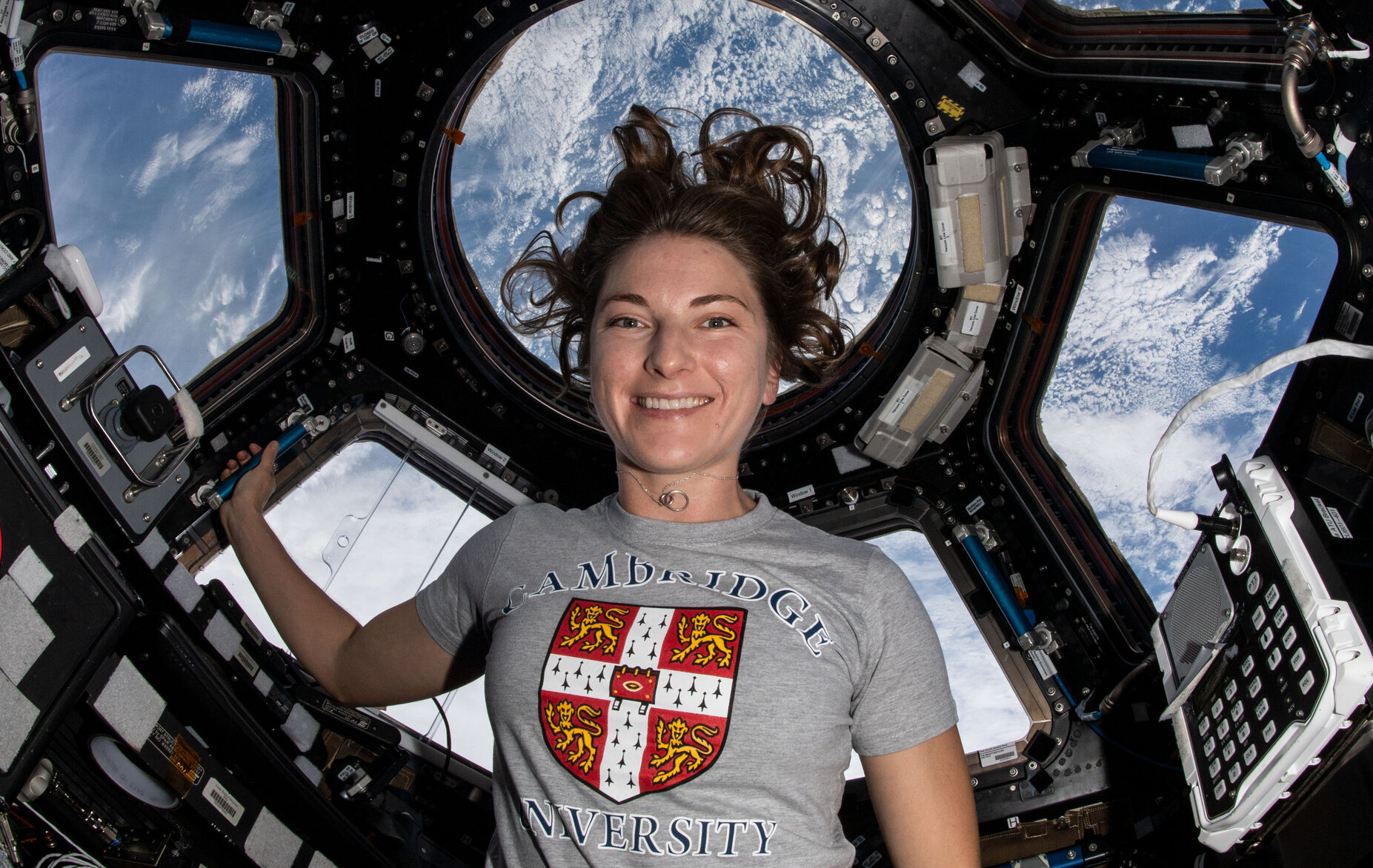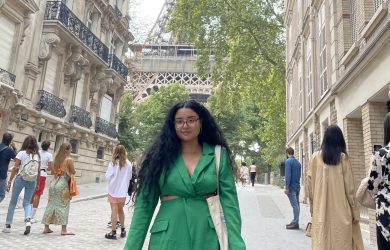
Kayla Barron spoke to Gates Cambridge Scholars about spending six months on the international space station as a NASA astronaut.
Being in space made me feel very small, but very encouraged that we can do such incredible things when we come together which can benefit human kind.
Kayla Barron
Kayla Barron never imagined that she would be an astronaut when she was a Gates Cambridge Scholar back in 2010/11. But through being open-minded and taking ‘one decision at a time’, inspired by a desire to find where she could contribute and challenge herself the most, she made it into space. Just back from a six-month stint at the international space station, Kayla met with Gates Cambridge Scholars yesterday and spoke about her time at NASA, her career and the role played by Cambridge, having famously been pictured in space in a Cambridge University t-shirt.
She said that in addition to a fierce desire to improve the lives of others – the Gates Cambridge mission, she had also been careful to surround herself with people and mentors who make her learn more about herself. The Gates Cambridge scholarship was “a huge part of that”, she stated.
Kayla started her MPhil at Cambridge in Engineering in 2010 after doing her undergraduate studies at the Naval Academy where she says the student pool was more homogenous – mainly white, American men who studied engineering. Kayla was keen to learn in a more diverse environment and she says Cambridge “opened my eyes to incredible passions and ways in which people can contribute”. “It changed how I thought permanently,” she says simply.
After Cambridge, Kayla went back to the navy and became part of the first group of women to become submarine warfare officers. Kayla said she had never imagined being an astronaut until she served on a submarine. She compared the environment on a submarine with that in space, the sense of being part of a team focused on specific operations and her realisation, after meeting an astronaut, that the international space station was in effect “a submarine in space”.
She says the timing of NASA’s application process was just right for her. At the time she was working on events and she went with her boss and mentor to an event where she met a number of astronauts. Her boss encouraged her to apply to NASA. “He asked me how you become an astronaut to which the answer was ‘you apply’,” said Kayla, comparing the advice with the process of becoming a Gates Cambridge Scholar – another role she had never imagined herself in before a mentor encouraged her to apply.
Life in space
Just back from six months as part of the Space-X Crew-3 mission to the international space station – she returned in May – Kayla said the trip had changed her perspective in ways she would never have been able to anticipate. She showed a short film which gave a flavour of her time there which followed two years of intensive training. During the six months the crew took part in over 350 experiments and Kayla worked with free-flying robots and nano satellites and operated a robotic arm. She went on two space walks, one to replace a communication antenna and the other to install a support system for equipment which had degraded due to the impact of micro meteorites. She described the ‘ride home’ as more spectacular than the journey to the space station because the astronauts were able to see from the windows the light pink plasma glow and sparklers as they left the space station. They landed by parachute in the Gulf of Mexico, with Kayla describing the once pristine white capsule as looking like ‘a toasted marshmallow’.
She told Scholars that the experience was life-changing in many ways, particularly the opportunity to carry out so many experiments which could be of benefit to humans everywhere.
Women in space
Kayla also spoke of being a woman in a male-dominated world – a third of NASA astronauts are women, but this was part of the historic legacy and was changing, she stated, although she was the only woman on the station until the handover crew arrived. She said working in a male-dominated world was something she has encountered throughout her career and that the space programme was diverse in many ways and was working towards a 50/50 gender split.
When it came to personal qualities, she said that it was important to be vulnerable and to be herself. This she had learned as a leader in the navy – owning her mistakes and learning from them, sharing her weaknesses and being real helped build trust and allowed others to be similarly vulnerable, creating a stronger team. In an environment where you live and work together and rely on each other for your survival, that trust matters, she said.
Kayla was asked about the psychological transition of being in space. She spoke of how she had trained for life in micro gravity both in a spacesuit in a swimming pool for the micro gravity of space and using virtual reality. Being with a team who were going through the same experience helped, she said, for instance, the whole team would stand on the ceiling together and look at the space station from different angles. She said there was no way to prepare for the emotional side of the experience except to know that living in micro gravity was a gap in your understanding that you would have to bridge. It was like having to learn how to move all over again, she stated.
Kayla added that coming back from space where all her time was scheduled around important tasks was difficult to adapt to. Her husband Tom, a fellow Gates Cambridge Scholar who had served in the military and now works on immigration policy in the White House, had helped a lot. She compared the feelings she had with a soldier returning from a tour of duty and the challenge of relating to civilian life. Tom understood that and was very supportive, she said.
An emotional and peaceful experience
Kayla was asked about the emotional experience of seeing Earth from afar. She said everyone experienced it differently. She described the ‘space romance moment’ of docking at the space station and the station being lit up by the sun and ‘shining gold’ in front of the crew as well as the views she got on her space walks as she drifted in ‘the vacuum of space’ and saw the whole Earth in one glance. Her first impression was that Earth is a biosphere and she noted how fragile it is as she traced the edge of Earth’s atmosphere which separates it from space. “It’s crazy to imagine that,” she said. “It made me feel very small, but very encouraged that we can do such incredible things when we come together which can benefit human kind.”
Kayla was also asked about how the budget for NASA could be justified given the challenges on Earth. She said the NASA budget was less than half a per cent of the US federal budget and that the experiments they were doing primarily aimed to improve life on Earth, with cell cultures growing differently in space. There was, she said, a huge return on investment for every dollar spent, although it was important to be thoughtful about where money was invested. She added that there was also other less tangible value in space exploration, for instance, in terms of international cooperation. In space, there was still a functioning relationship with Russian astronauts. “It is a peaceful place where we cooperate towards common goals,” she said. “There’s something existential about coming together to inspire the next generation.”
What next?
Kayla is now in a six-month post flight period which has included her visit to Cambridge and a 200-mile walk with her mother in the UK. She says that when she returns from her break she hopes to contribute to the Artemis programme and to one day venture to the moon where NASA can learn all it needs to know to get astronauts onto Mars. Kayla hopes to be one of these and to contribute her knowledge about engineering and her time in space to the programme. “I hope I am assigned to the Artemis mission and get to go to the moon,” she said. “That would be a dream Just seeing the moon from space was so beautiful and exciting. To be there would be awesome.”

*Top picture credit: NASA. The picture above shows Kayla [centre in black] with Scholars in the Gates Cambridge room.












